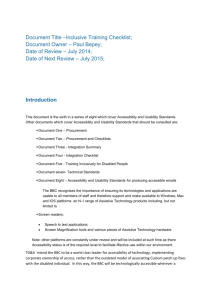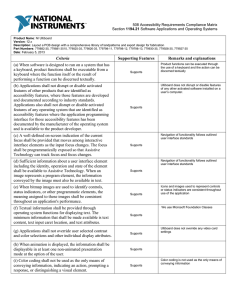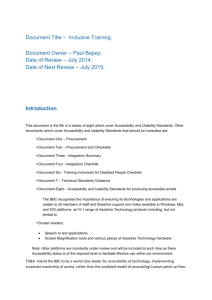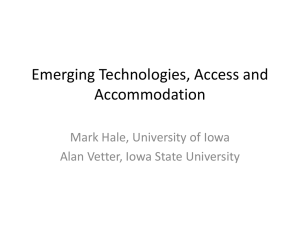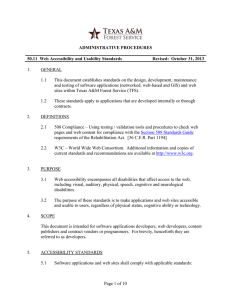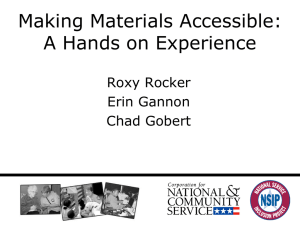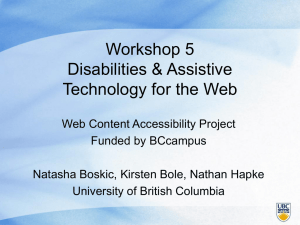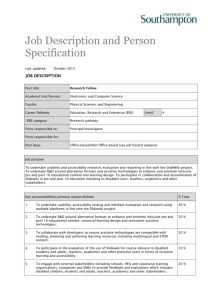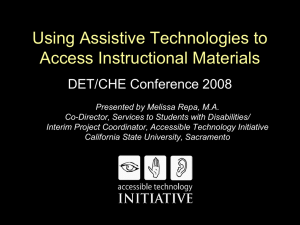Accessible Emails
advertisement
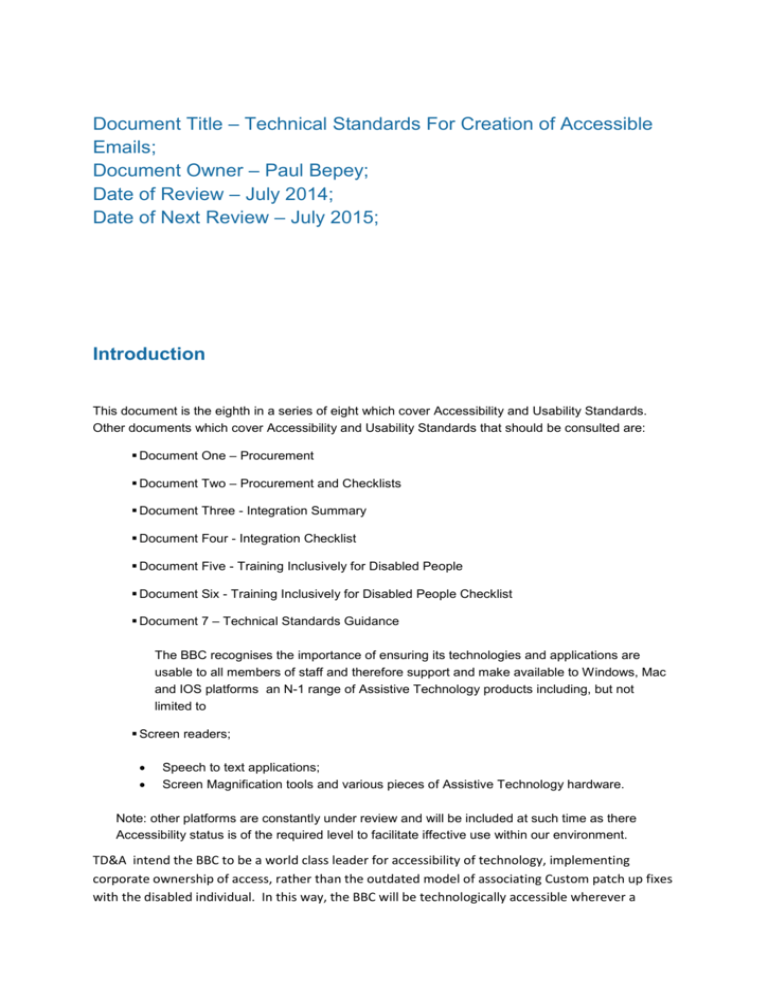
Document Title – Technical Standards For Creation of Accessible Emails; Document Owner – Paul Bepey; Date of Review – July 2014; Date of Next Review – July 2015; Introduction This document is the eighth in a series of eight which cover Accessibility and Usability Standards. Other documents which cover Accessibility and Usability Standards that should be consulted are: Document One – Procurement Document Two – Procurement and Checklists Document Three - Integration Summary Document Four - Integration Checklist Document Five - Training Inclusively for Disabled People Document Six - Training Inclusively for Disabled People Checklist Document 7 – Technical Standards Guidance The BBC recognises the importance of ensuring its technologies and applications are usable to all members of staff and therefore support and make available to Windows, Mac and IOS platforms an N-1 range of Assistive Technology products including, but not limited to Screen readers; Speech to text applications; Screen Magnification tools and various pieces of Assistive Technology hardware. Note: other platforms are constantly under review and will be included at such time as there Accessibility status is of the required level to facilitate iffective use within our environment. TD&A intend the BBC to be a world class leader for accessibility of technology, implementing corporate ownership of access, rather than the outdated model of associating Custom patch up fixes with the disabled individual. In this way, the BBC will be technologically accessible wherever a disabled person happens to log in and will enable them to move from work-station to work-station or studio to studio. This document provides information and guidance to ensure that any Email sent to members of BBC staff, some of whom may be users of assistive technology, is accessible and usable. Note that although these standards and guidelines refer to internal emails sent corporation-wide, departmentwide or to a distribution list, realistically the same standards should be considered for emails to individuals or sent externally. Email is one of the simplest forms of communication and usually causes no accessibility issues at all. However, some practices have developed in recent times which are putting the full accessibility of the information we send to each other at risk. The following are a series of guidelines/standards that must be considered/adhered to. General Guidelines Emails must be sent in HTML, plain text or rich text. Plain Text and Rich Text are accessible by their nature (subject to the guidelines below). Full guidelines relating to HTML content can be found in Document 7 of this series and at http://www.w3.org/WAI/WCAG20/quickref/ Any picture/graphic that conveys information contained within an email must have appropriate Alternate (ALT) text tagging to fully describe that picture or explain its context within the email. To add ALT text, right-click the image, select ‘properties’ then complete the ‘Alternate Text’ field. Specifically, if Auto Signatures are images they must have ALT text assigned. One common issue found by users of assistive technology involves Auto Signature images containing Fax/Phone numbers, which are then not accessible. Often screen dumps are a useful way of conveying information in a message but if included they must either be tagged with fully descriptive ALT text or have a full textual description included as part of the message. Text must be well spaced out into separate paragraphs to improve ease of reading. The language used must be simple without being patronizing. Consider the length of the mail you are sending. Specifically ask yourself the following question: o o o Do the recipients need to know everything? Is there somewhere else this information resides that I can be linked to. Can a long email be better structured? See below for suggestions. If emphasising (bold, underline, ALL CAPS) more than 3 or 4 words in a paragraph, the emphasis loses all effectiveness. Multiple colours, fonts, sizes and styles can be effective for sighted recipients but information conveyed by changes in font attributes are not accessible to visually impaired users. For example ‘refer to text in red’ would be fine for many readers, but would not be accessible for visually impaired recipients so alternative sign-posting is required. For example - ‘refer to text in red or go to section entitled Accessible Text at the end of this message’. All multimedia content (e.g. audio and video) must incorporate Subtitles (or some other text equivalent) or Audio Description. Email Structure A long email can often be better structured to be more readable by using: bulleted lists, correct emphasis, breaking up long paragraphs. In long email threads consider deleting unnecessary threads. When designing a structured email, for example a newsletter with various headings, it is important to follow a logical structure, similar to that used on accessible websites: only include one H1 heading at the top and include headings at other levels in a hierarchical fashion. If the mail contains hyperlinks then link text must make sense out of context, for example avoid ‘Click here’ or “More” as links. Sending attachments The preferred format of documents sent as attachments is Microsoft Office: Word, Excel etc. (though note that if sent externally there is no guarantee that the recipient will have a copy of the Microsoft Office suite). Guidelines on the Accessibility and Usability of Office documents can be found in Document 7 of this series. Plain text documents are also perfectly acceptable. Where possible users should avoid sending PDF documents as attachments. PDF documents can present severe difficulties to a user of assistive technology even to the extent of being completely unreadable. Attachments conveying information should not be sent as images, for example .BMP or .JPG as these formats are completely inaccessible to users of screen readers. If the image contains important information then it can be attached but a textual description of that information must be included either as part of the message or as an attachment in textual form. Any multimedia content sent as an attachment must incorporate Subtitles (or some other text equivalent) or Audio Description. History Version 0.1 Date 29/03/2010 Author Claire Jennings 0.2 29/03/2010 Paul Bepey 0.3 09/04/2010 Terry Clarke 0.4 09/06/2010 Russ Brattan 0.5 0.6 23/06/2010 22/10/2010 Paul Bepey Terry Clarke 0.7 3/12/2010 Terry Clarke 0.8 12/01/11 Rizwan Nazir Description Created draft strategy Added/Amended wording Addition of usability guidelines and reformatting Added short Scope and Policy sections Amended wording Update to contact details. Include specific details about subtitles and audio description. Minor amendments. Any comments, queries or change control requests about this document Should be addressed to: Paul Bepey (Access Technology Manager)
